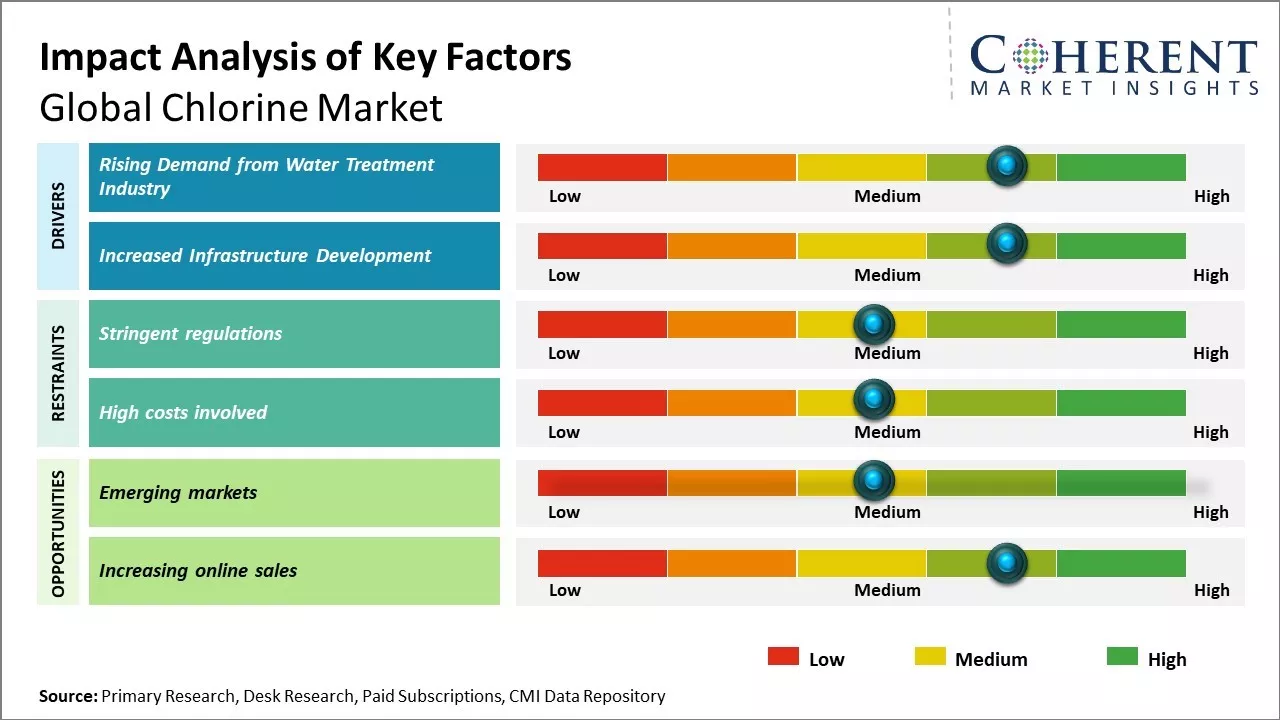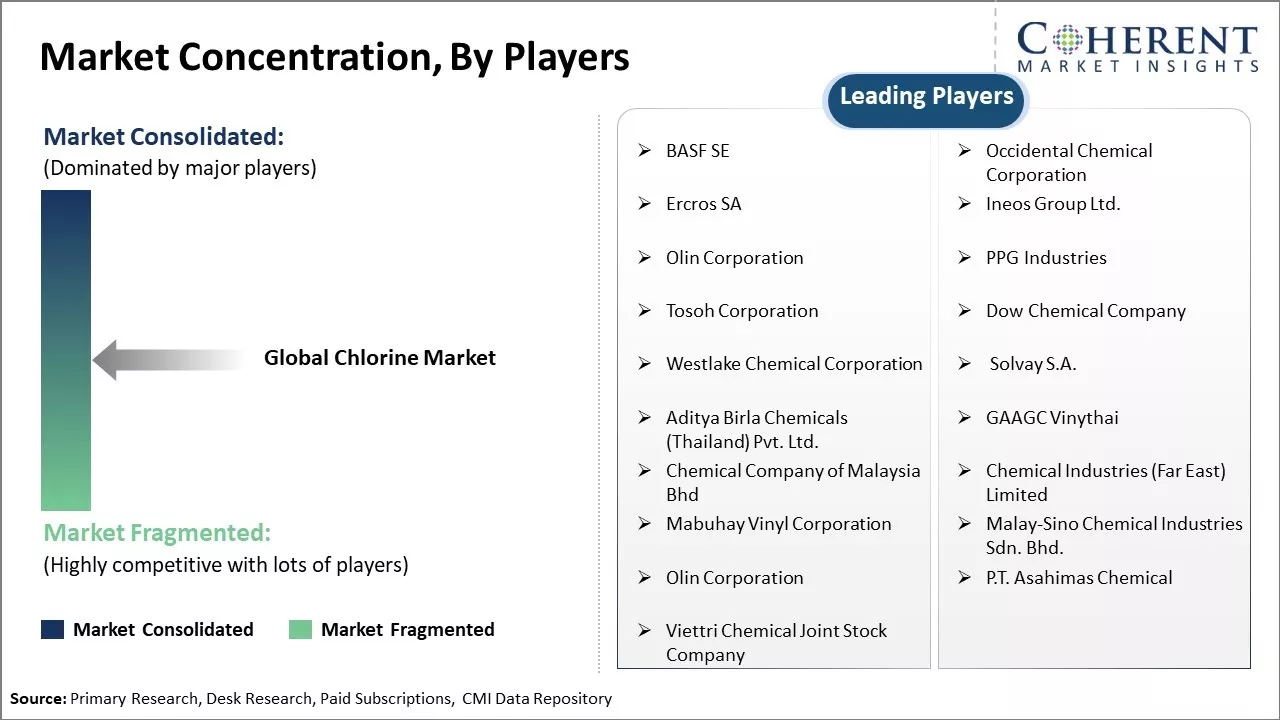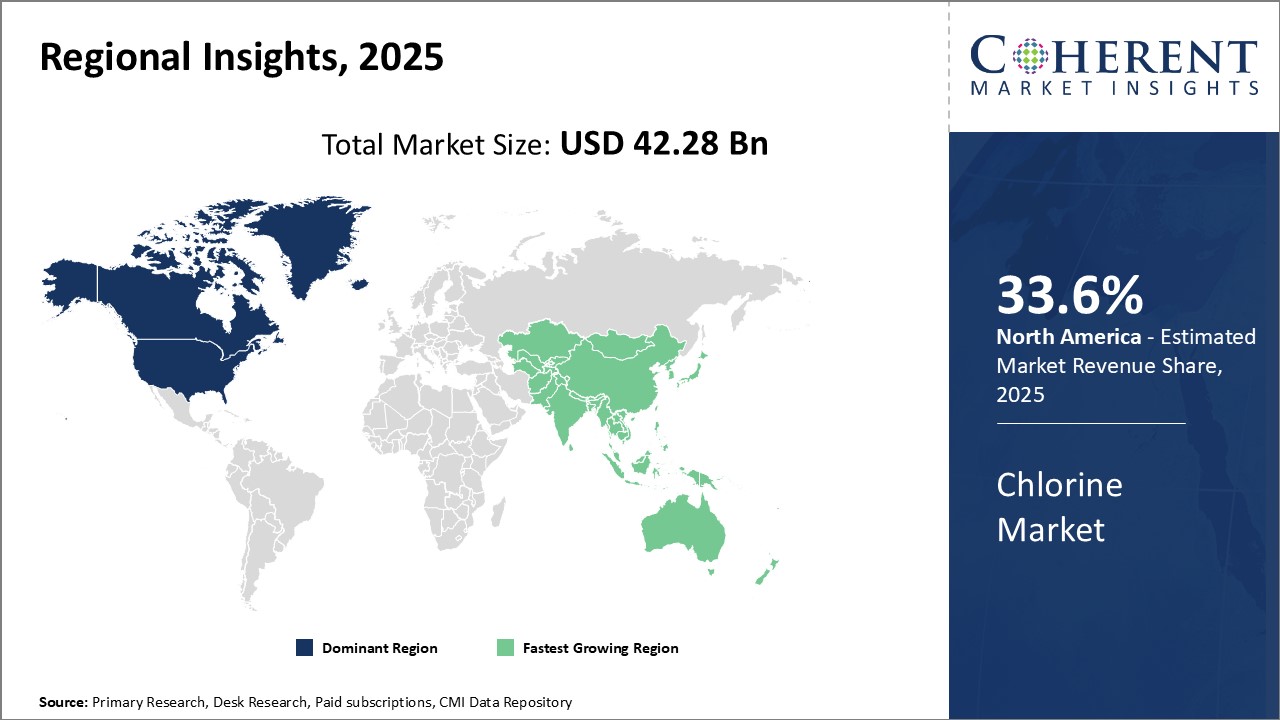The global chlorine market is estimated to be valued at USD 42.28 Bn in 2025 and is expected to reach USD 56.80 Bn by 2032, exhibiting a compound annual growth rate (CAGR) of 4.3% from 2025 to 2032.

Discover market dynamics shaping the industry: Request sample copy
As a core component in PVC production, chlorine continues to see steady demand globally from the construction industry. While demand may fluctuate slightly with macroeconomic conditions, the non-discretionary nature of products containing chlorine means that consumption is less vulnerable to economic downturns compared to more luxury-oriented industries. Effective replacement of chlorine also remains a challenge given its unique chemical properties, ensuring ongoing need from industrial applications. Any major disruptions would require developers to find suitable substitute compounds that can fulfill the same functionalities as chlorine in terms of reactivity and cost profile. Barring such developments, the market is forecast to see mostly consistent expansion out to 2032.
Rising Demand from Water Treatment Industry
The water treatment industry has seen immense growth in recent years as access to clean drinking water has become a high priority around the world. As populations and cities expand, so does the need to treat larger volumes of water to meet safety and health standards. Chlorine plays a crucial role in water disinfection, helping to kill harmful bacteria and pathogens that can pollute water sources. Most municipal water treatment facilities now rely on chlorine to purify water before it reaches homes and businesses. With urbanization continuing apace, especially in developing regions of Asia and Africa, the number of people requiring treated water will keep rising exponentially. This translates to higher consumption of chlorine by water treatment plants and establishments. Various countries have also tightened regulations for water quality, upping the chlorine dosage levels that must be adhered to. As awareness about waterborne diseases spreads and water scarcity becomes more prevalent, demand from this sector will remain robust for chlorine in the foreseeable future.

Get actionable strategies to beat competition: Request sample copy
Increased Infrastructure Development
Rapid infrastructure growth has been a defining feature of the developing world economy in recent decades. Huge investments are being made in building new highways, rail lines, airports, seaports, power plants, pipelines, residential and commercial complexes - essentially expanding the core infrastructure that supports industry and economic activity. Chlorine is used to produce indispensable materials like polyvinyl chloride (PVC), ethylene dichloride (EDC), ethylene chloride (EC) that then find application as plastics, pipes, insulation, roofing sheets, paints and other infrastructure-grade products. The infrastructure boom has led to a boom in demand for these end-use materials as well. With infrastructure development likely to remain a high priority spending area for governments worldwide, underpinned by the need for better transport, energy, and housing facilities, it ensures the contribution of chlorine to this sector will keep growing in the coming years. Both developing and developed market regions are participants in the ‘build-out’ underway, offering lucrative business opportunities for chlorine producers.
Key Takeaways from Analyst:
The global chlorine market growth will continue to be driven by demand from the water treatment and pulp & paper industries which utilize chlorine in their daily processes. Regions with higher industrial activity, such as Asia Pacific and North America, will likely see higher consumption. Emerging economies experiencing rapid industrialization could present new opportunities for chlorine producers.
Environmental regulations around the use of chlorine may pose a challenge. Stricter norms governing industrial discharge in major markets could potentially hamper demand growth. Supply chain disruptions due to geopolitical issues also remain a risk. Substitution with alternative chemicals is a threat particularly in developed nations where end users focus more on sustainability. Europe is expected to see moderate growth as its economy remains subdued.
Demand from mature markets may see slower growth, emerging economies in South Asia and Latin America will likely emerge as high potential regions. Their large and growing population as well as industrial activity will drive higher chlorine consumption over the coming years. Producers should focus on expanding their footprint in these untapped markets to benefit from rising opportunities. Incremental gains in these regions could help offset challenges faced in the mature markets.
Market Challenges: Stringent regulations
Stringent regulations around the production and use of chlorine are posing challenges for the expansion of the global chlorine market. Governments across major markets are introducing stricter environmental and safety norms to curb harmful emissions from chlorine plants as well as regulate end-use applications where chlorine is utilized. Compliance with evolving emission standards require significant investments from chlorine producers in upgrading pollution control equipment and transitioning to greener production technologies. For example, the installation of advanced scrubbers and emission treatment systems in chlorine production units entail capital expenditures running into millions of dollars. Moreover, the additional operating expenses for regular monitoring and maintenance of such equipment directly impacts the profit margins of manufacturers. As a result, many small to mid-sized chlorine producers find it difficult to consistently comply with frequent changes in regulations, hampering their production capacities and ability to scale operations.
Market Opportunities: Emerging markets
Emerging markets have the potential to drive significant growth in the global chlorine market in the coming years. Many developing economies across Asia, Africa, and South America are witnessing strong industrialization and infrastructure development. Chlorine and its derivatives have widespread applications in sectors that are seeing increased investment and construction in these regions. For instance, PVC is used extensively in pipes for water supply and sewage systems. As access to clean water and sanitation remains a development priority, there is growing demand for PVC pipes from governments and construction companies.

Discover high revenue pocket segments and roadmap to it: Request sample copy
Insights by form : Strong Density and Durability Drive Powder Demand
In terms of Form, the Powder segment is estimated to account for 68.7% share of the global chlorine market in 2025, owing to its dense and durable properties. Chlorine in powder form allows for highly concentrated and compact storage and transportation compared to liquid or gas forms. This makes powder chlorine particularly useful for applications where space is limited or chlorine needs to be kept on site for extended periods. The powder also has a longer shelf life than liquid or gas, retaining its chemical properties for longer without degradation. Powder chlorine's dense and solid structure provides protection against leakage and spillage, avoiding hazards associated with transporting pressurized liquids or gases. Its non-flowing nature supports safe handling and makes powder less prone to accidental releases. These safety benefits have driven its use where risk of contamination is a major concern such as water treatment facilities. The strong particulate form is also corrosion resistant and does not require specialized pressurized storage vessels. This makes powder chlorine well-suited for applications in remote or harsh environments with limited infrastructure.
The durable nature of powder chlorine means it can withstand varied temperatures and pressures without undergoing a phase change. This thermal and pressure stability permits flexible storage and use across climates zones worldwide. It also means powder chlorine production and transport is not as energy intensive as liquefying or gasifying chlorine. The energy efficiency of powder production and its long shelf life have further increased its appeal amid rising energy costs. Strong demand from industries requiring high concentration and thermal stability chlorine will continue propelling the powder segment’s leading market position.
Insights by packaging : Bags Facilitate Flexible Small-Volume Delivery
In terms of Packaging, the Bags segment is estimated to account for the 52.8% share of the Global Chlorine market in 2025, owing to their practicality for small-volume deliveries. Chlorine is used in limited quantities by many municipal water authorities and smaller industrial plants. The bag packaging format allows efficient delivery of chlorine matched to these users' needs. Bags are inexpensive to produce compared to drums and can hold anywhere from 25 to 900 pounds of powder or liquid chlorine.
Their lightweight and compact form reduces shipping costs of partial loads versus bulkier packaging alternatives. Bags are also easy to handle, store, and dispense chlorine from via pouring or cutting open. This convenience is well-suited to the requirements of distributed local facilities. Empty bags are compact for waste disposal as well. Furthermore, multiple bags can be bundled together on a pallet for consolidated shipping if larger volumes are required. By offering flexible quantity increments down to the pound level, bags eliminate need to purchase excessive amounts of chlorine not immediately required. This improves cash flow and reduces unnecessary chemical storage challenges for buyers. The re-sealable nature of bags prevents chlorine exposure and egress of gases, ensuring product stabilization until used. Overall, bags deliver an optimally sized packaging methodology for chlorine distribution to smaller point-of-use locations driving their widespread preference.
Insights by application : Universal Applications Spur Disinfection Demand
In terms of Application, the Disinfection segment is estimated to represent 40.3% share of the chlorine market in 2025, owing to its necessity across diverse sectors. Chlorine is the most commonly used disinfectant chemical worldwide. It is applied for treatment of municipal drinking water supplies and wastewater effluent to eliminate pathogenic microbes ensuring public health. Chlorine is also extensively used for disinfecting medical equipment, pharmaceutical products, and surfaces in hospitals to avert infection risks. Food processing plants heavily rely on chlorine to sanitize meat, seafood and produce conveyed through production lines. It disinfects food contact surfaces and equipment with its broad-spectrum microbial control. Chlorine disinfects livestock drinking water, pens, and enclosure areas to control zoonotic disease spread.
Swimming pools worldwide use chlorine to destroy waterborne bacteria and viruses. It is the disinfectant of choice for cooling towers, air conditioning units and other heat transfer systems vulnerable to microbial contamination and Legionella growth. Chlorine also finds disinfection applications in industrial process water treatment across diverse sectors like oil & gas extraction, manufacturing and mining. Given chlorine's potent yet cost-effective disinfection, universal regulatory acceptance and logistical advantages over alternatives, demand from these varied critical applications will continue propelling the disinfection segment. Its indispensable role in public health protection cements chlorine as the leading disinfectant globally underpinning segment growth.

Need a Different Region or Segment? Customize now
North America has established itself as the dominant player in the global chlorine market and is estimated to account for 33.6% share in 2025. With a strong presence of major chemical producers in countries like the U.S. and Canada, the region accounts for the largest market share. The industrial output and consumption of chlorine and downstream derivatives like vinyl chloride monomer, polyvinyl chloride and ethylene dichloride has been consistently high. Stringent environmental and safety regulations related to chlorine production and usage have led to technological advancements, allowing North American manufacturers to gain significant operational efficiencies and cost advantages over others. Furthermore, cheap availability of raw materials like natural gas and salt have provided additional impetus for growth. Overall industry expertise, economies of scale and proximity to major end-use markets have enabled the region to thrive as a chlorine exporter as well.
Asia Pacific has emerged as the fastest growing regional market for chlorine in recent years. Countries like China, India, and Southeast Asian nations have witnessed rapid industrialization and infrastructure development. This has bolstered the demand for plastics, polymers and several other derivatives where chlorine is a key raw material. China, in particular, is leading this growth story on the back of its growing manufacturing and construction sectors. Availability of affordable labor and resources has attracted many international chlorine producers to establish facilities in the region. While domestic production has increased dramatically, imports also remain consistently high to meet the massive demand. Though still developing, regulations around safety, environment and exports are getting strengthened in Asia Pacific. This will pave way for more organized growth and further consolidate its position as the future engine of the global chlorine industry.
Chlorine Market Report Coverage
| Report Coverage | Details | ||
|---|---|---|---|
| Base Year: | 2024 | Market Size in 2025: | USD 42.28 Bn |
| Historical Data for: | 2020 To 2024 | Forecast Period: | 2025 To 2032 |
| Forecast Period 2025 to 2032 CAGR: | 4.3% | 2032 Value Projection: | USD 56.80 Bn |
| Geographies covered: |
|
||
| Segments covered: |
|
||
| Companies covered: |
BASF SE, Occidental Chemical Corporation, Ercros SA, Ineos Group Ltd., Olin Corporation, PPG Industries, Tosoh Corporation, Dow Chemical Company, Westlake Chemical Corporation, Solvay S.A., Aditya Birla Chemicals (Thailand) Pvt. Ltd., GAAGC Vinythai, Chemical Company of Malaysia Bhd, Chemical Industries (Far East) Limited, Mabuhay Vinyl Corporation, Malayâ€Sino Chemical Industries Sdn. Bhd., Olin Corporation, P.T. Asahimas Chemical, and Viettri Chemical Joint Stock Company |
||
| Growth Drivers: |
|
||
| Restraints & Challenges: |
|
||
Uncover macros and micros vetted on 75+ parameters: Get instant access to report
*Definition: The global chlorine market consists of companies that produce and supply chlorine gas and its derivatives for use in various industries worldwide. Chlorine is a key raw material used to make products like PVC, polyurethane, solvents, refrigerants, chloromethane, and propylene oxide. It is also used as a disinfectant and bleaching agent. The global chlorine market is expected to grow steadily driven by increased demand from industries like water treatment, pharmaceutical, construction.
Share
Share
About Author
Yash Doshi is a Senior Management Consultant. He has 12+ years of experience in conducting research and handling consulting projects across verticals in APAC, EMEA, and the Americas.
He brings strong acumen in helping chemical companies navigate complex challenges and identify growth opportunities. He has deep expertise across the chemicals value chain, including commodity, specialty and fine chemicals, plastics and polymers, and petrochemicals. Yash is a sought-after speaker at industry conferences and contributes to various publications on topics related commodity, specialty and fine chemicals, plastics and polymers, and petrochemicals.
Missing comfort of reading report in your local language? Find your preferred language :
Transform your Strategy with Exclusive Trending Reports :
Frequently Asked Questions
Joining thousands of companies around the world committed to making the Excellent Business Solutions.
View All Our Clients
US Reciprocal Tax Impact Analysis On Chlorine Market
Stay updated on tariff changes with expert insights and timely information